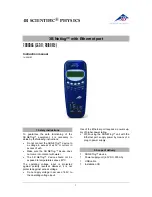
ACAM_64
4
Figure 1
An array of microphones captures the sound waves hitting the array from many different directions. For
every pixel, a massively parallel digital processing engine applies specific delays, and sums the acoustic
signals from every microphone, so that the signals from a specific angle of incidence (azimuth and
shows that process for a single pixel. Note that a different and
precisely adjusted delay must be applied to every path, from every microphone in array to every pixel in
the image. In the simplest implementation, the intensity of every pixel is calculated as the energy of that
sum signal, averaged over a specific length of time.
3.1
Frequency, Aperture Size, and Image Resolution
For an optical camera, as well as for an acoustic camera, the image resolution is a proportional to the
ratio of aperture size to wavelength.
For an optical camera the aperture size of the camera (the size of the lens or more generally the light
collector) is always very large relative to the wavelengths of interest. This is true even for very small
lenses, such as those found in camera phones, where the size of the lens is a few mm, while the
wavelengths of interest are in the hundreds of nm (more than 10000 times smaller). For an optical
camera, resolution is rarely limited by the size of the aperture.
For an acoustic camera on the other hand, the frequencies of interest often extend to quite low
frequencies (long wavelengths). For instance, the wavelength at 100 Hz is 3.4 m. To have a reasonable
resolution at such low frequency would require an array of at least 8 to 10 times as large (25 to 30 m
wide). This is usually not practical. Therefore, for acoustic cameras the resolution is typically poor at lower
frequencies and improves only as the frequency of interest increases.
3.2
Spatial Sampling and Upper Frequency Limit
For an acoustic camera, the maximum frequency is limited by the spatial separation between two
adjacent microphones. The half wavelength of the maximum frequency sampled by the microphones
must be wider than the distance between two microphones. Otherwise, the array is not able to distinguish





























